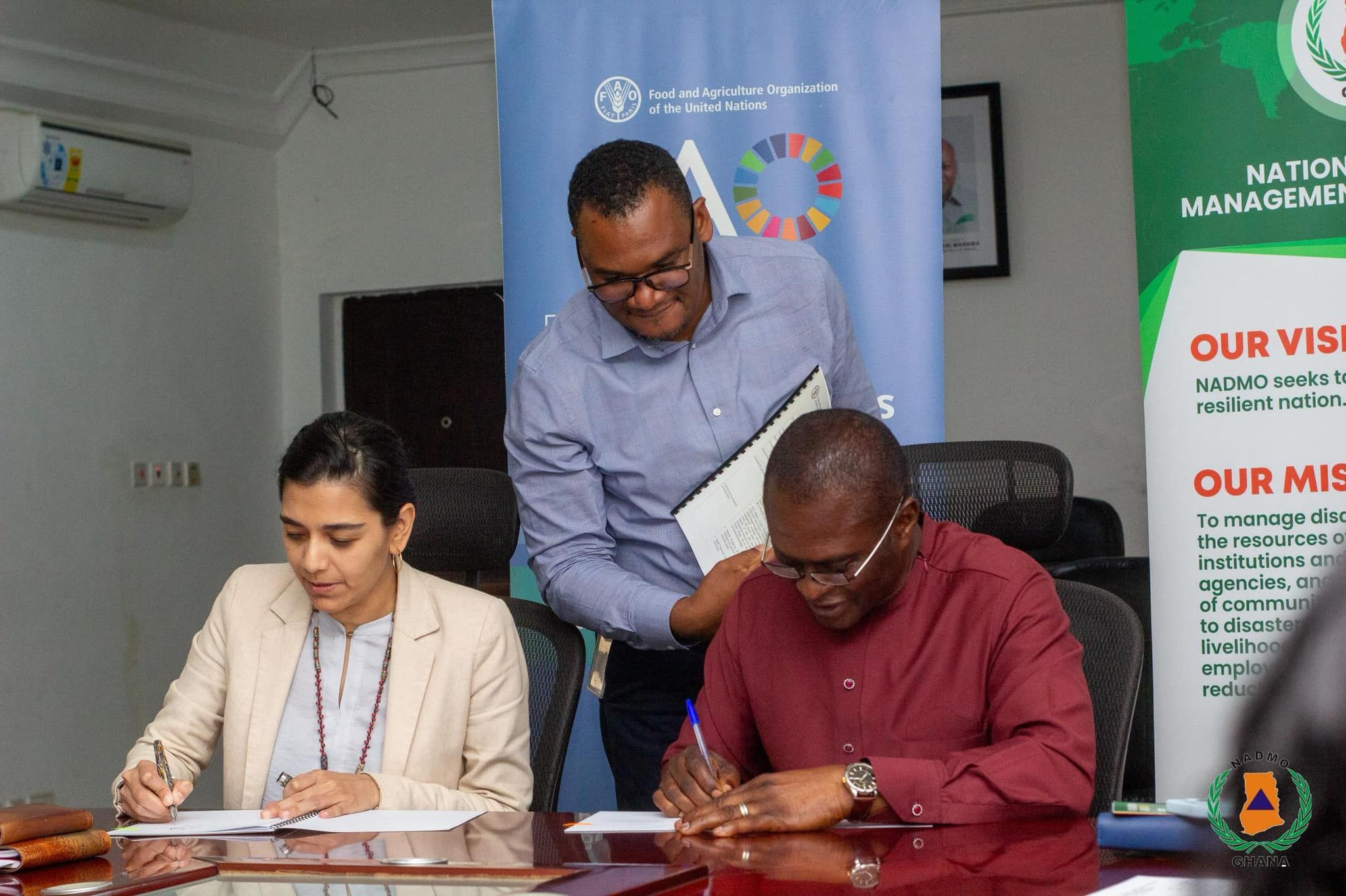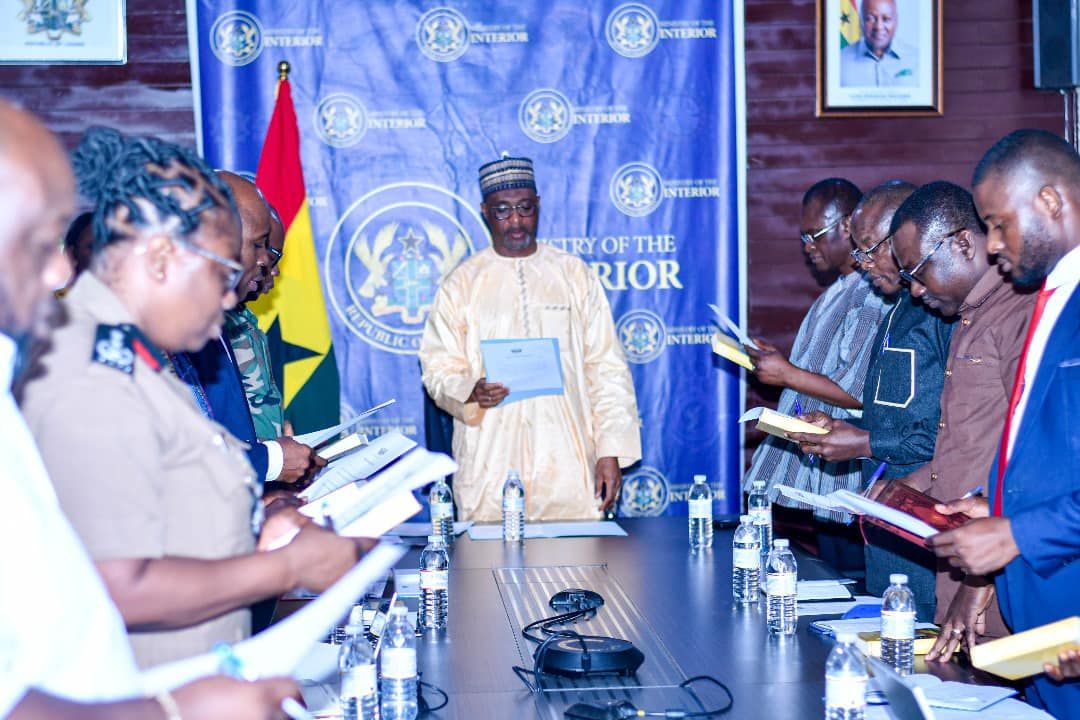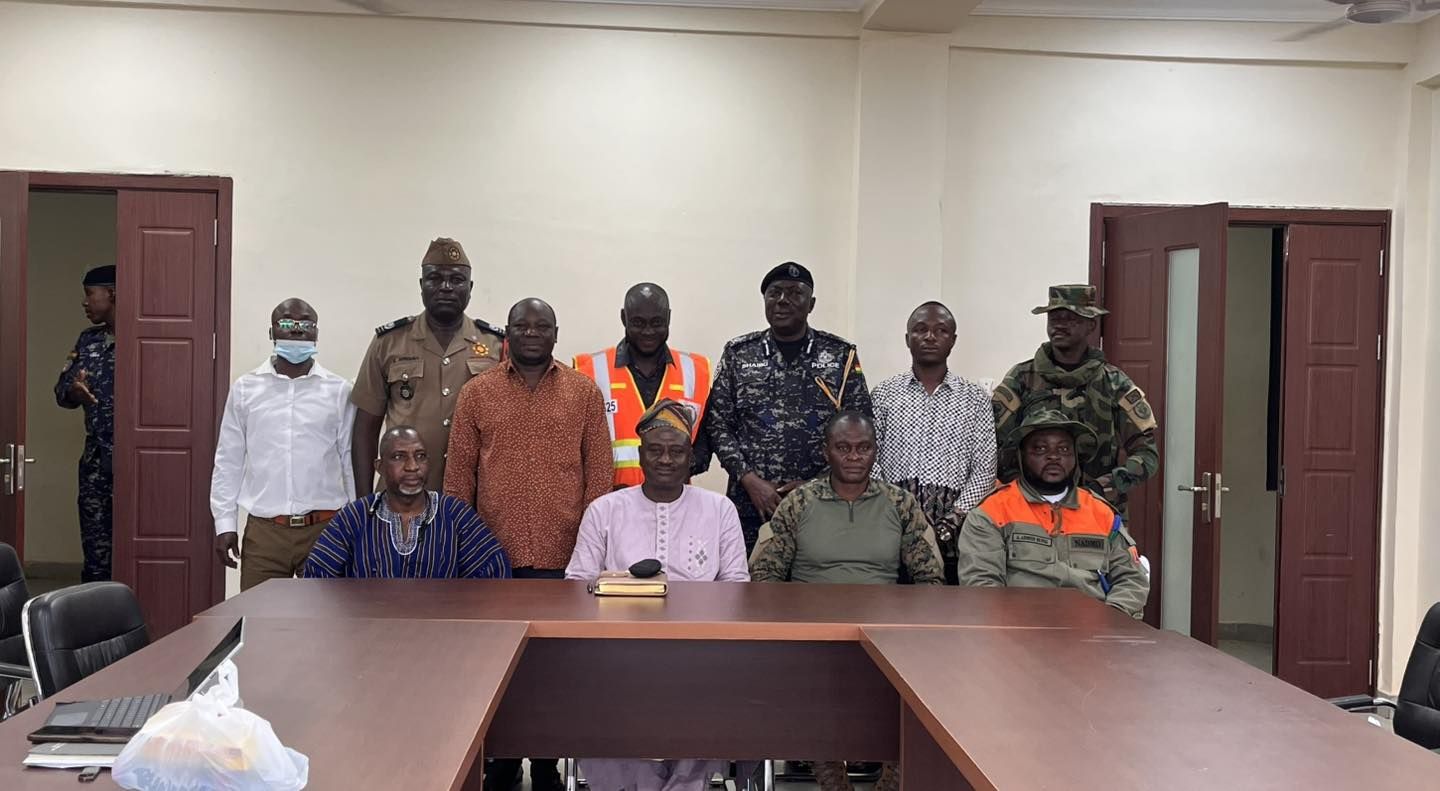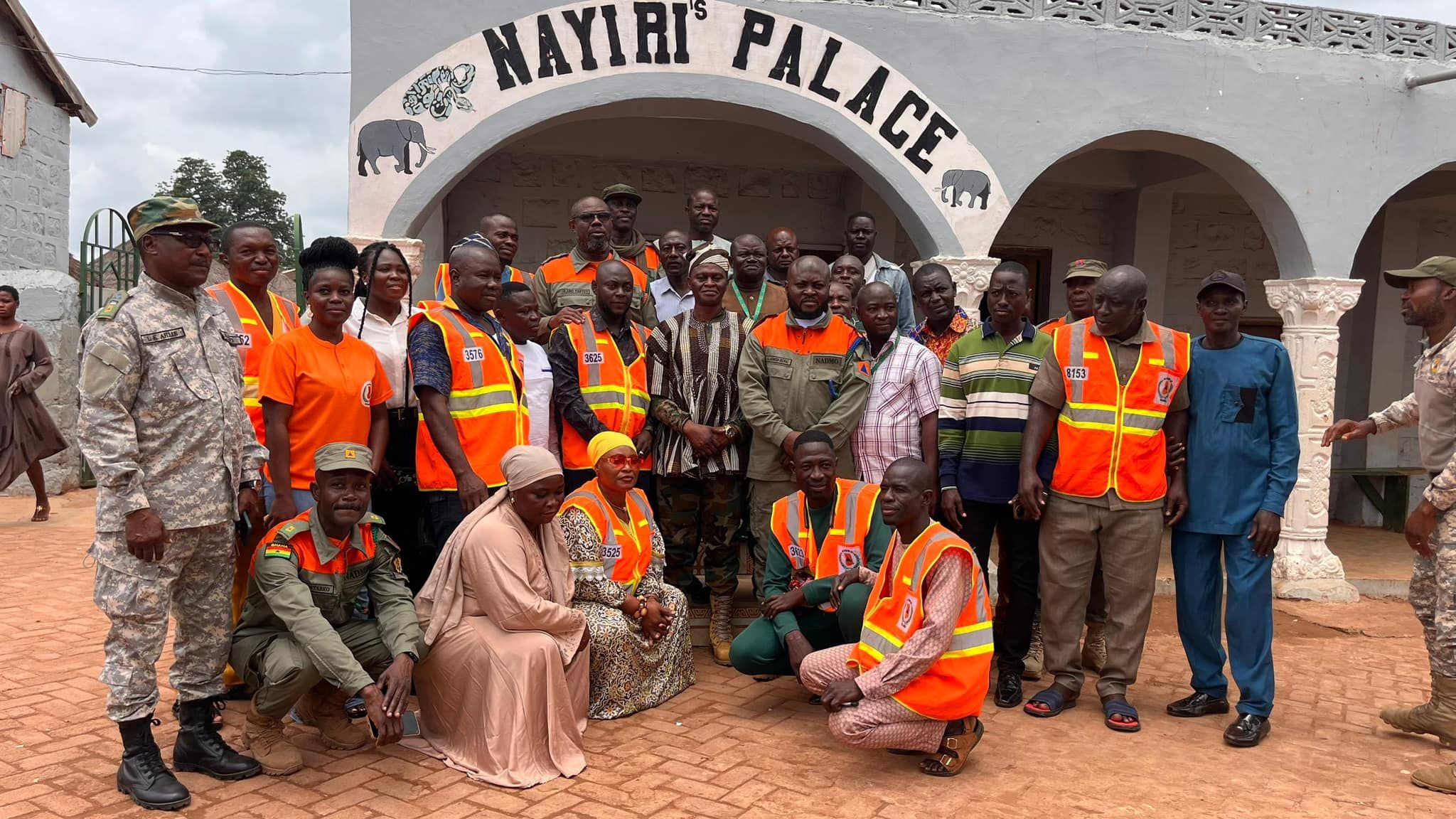-
![]()
ZIMBABWEAN DELEGATION, IOM ENGAGE NADMO ON GENDER-SENSITIVE RETURN AND REINTEGRATION STRATEGIES
The visit seeks to support Zimbabwe in adopting a whole-of-government and whole-of-society strategy that is both integrated and gender-sensitive. This approach is expected to strengthen the country’s capacity to respond to the economic, social, -
![]()
FAO AND NADMO STRENGTHEN COLLABORATION TO BUILD RESILIENT AGRIFOOD SYSTEMS AND ONE HEALTH IN GHANA
The Food and Agriculture Organization of the United Nations (FAO) and the National Disaster Management Organisation (NADMO), on 16th September 2025, signed an agreement on a road map to deepen collaboration on Disaster Risk Reduction and the One Health approach in Ghana. -
![]()
NADMO EXTENDS DISASTER VOLUNTEER GROUPS REACTIVATION TO VOLTA AND OTI REGIONS
The ongoing national exercise forms part of the organisation’s drive to reactivate the DVGs, which were inactive for several years until their recent reactivation. -
![]()
INTERIOR MINISTER INAUGURATES NATIONAL DISASTER MANAGEMENT COMMITTEE
The inauguration, held at the Ministry’s Conference Room in Accra, formally mandates the Committee to ensure that adequate facilities are available for relief, rehabilitation, reconstruction, and recovery in the event of a disaster. -
![]()
MAJOR (RTD) DR. KUYON INAUGURATES NORTH EAST REGIONAL DISASTER MANAGEMENT COMMITTEE
In his address, Dr. Kuyon noted that the committee had been inactive for some time. He commended the President for reviving the initiative in line with the NADMO Act, emphasizing the importance of proactive planning and coordination in protecting lives and property. -
![]()
NADMO BOSS URGES STRENGTHENED DISASTER PREPAREDNESS DURING UPPER WEST VISIT
The delegation was received by Hajia Pognaa Fati Issaka Koray, Chief Director of the RCC, and Alhaji Nura Issah Dawana, Municipal Chief Executive of Wa, who represented the Regional Minister. -
![]()
NADMO BOSS TOURS SAVANNAH REGION, ENGAGES LEADERS ON CONFLICT, DISPLACEMENT AND PEACE EFFORTS
The visit aimed to gather firsthand information on the recent conflict in the area and its impact on the local population. The Director General was accompanied by senior NADMO officials, including Mr. Ahmed-Rufai Aggudey, Deputy Director General for Technical; Mr. Maxwell Niber, Director of Man-Made Disasters; Mr. Amo Yartey, Director of Inspectorate; and Mr. Mahama Zakaria, the Savannah Regional Director.
- ZIMBABWEAN DELEGATION, IOM ENGAGE NADMO ON GENDER-SENSITIVE RETURN AND REINTEGRATION STRATEGIES
- FAO AND NADMO STRENGTHEN COLLABORATION TO BUILD RESILIENT AGRIFOOD SYSTEMS AND ONE HEALTH IN GHANA
- NADMO EXTENDS DISASTER VOLUNTEER GROUPS REACTIVATION TO VOLTA AND OTI REGIONS
- INTERIOR MINISTER INAUGURATES NATIONAL DISASTER MANAGEMENT COMMITTEE
- MAJOR (RTD) DR. KUYON INAUGURATES NORTH EAST REGIONAL DISASTER MANAGEMENT COMMITTEE
- NADMO BOSS URGES STRENGTHENED DISASTER PREPAREDNESS DURING UPPER WEST VISIT
- NADMO BOSS TOURS SAVANNAH REGION, ENGAGES LEADERS ON CONFLICT, DISPLACEMENT AND PEACE EFFORTS
ABOUT US
In the 1980’s, it was observed that the number of disasters and their impacts were increasing worldwide. This situation alarmed the United Nation Organisation which held various conferences on the issue, leading to the UN declaration of GAD 44/236 of 1989 declaring the 1990’s as the International Decade for Natural Disaster Reduction (IDNDR).
OUR OFFICES
NADMO HQ - Ghana
COVID-19
Coronaviruses are a large group of viruses that are common among animals. In rare cases, they are what scientists call zoonotic, meaning they can be transmitted from animals to humans, according to the US Centers for Disease Control and Prevention. It is a dangerous diseases with incubation period between 4-6 days. It is fatal especially for those with weakened immune system, the elderly and the very young. It could also result in Pneumonia and bronchitis.
Viruses can spread from human contact with animals and also from human to human.
When it comes to human-to-human transmission of the viruses, often it happens when someone comes into contact with the infected person's secretions. The exposure factors are;
- a cough
- sneeze or
- handshake
The virus can also be transmitted by touching something an infected person has touched and then touching your mouth, nose or eyes.
The viruses can make people sick. Coronavirus symptoms include;
- fever
- a runny nose
- cough
- sore throat
- possibly a headache
There is no vaccine to protect against this family of viruses. Reduce your risk of infection by
- Wash your hands with soap and water before touching anything including your eyes, nose and mouth
- Cover your mouth and nose when you cough or sneeze
- Disinfect the objects and surfaces you touch.
- If you are sick, stay home and avoid crowds and contact with others.
- There is no specific treatment. Most of the time, symptoms will go away on their own.
- Doctors can relieve symptoms by prescribing a pain or fever medication.
- A room humidifier or a hot shower can help with a sore throat or cough.
- Drink plenty of fluids
- Get rest and sleep as much as possible.
- If symptoms feel worse than a standard cold, see your doctor
NEWS
SOCIAL MEDIA
Subscribe to our Newsletter Now!
EDUCATIONAL MATERIALS
Disaster Profile in Ghana
- Domestic Fires
- Road Accidents
- Conflicts
Earthquakes
Flooding
Hazards
A hazard is a process, phenomenon or human activity that may cause loss of life, injury or other health impacts, property damage, social and economic disruption or environmental degradation. Hazards may be natural, anthropogenic or socionatural in origin (UNISDR, 2016).
Hazards are often categorized by whether they are natural (sometimes termed physical) or technological (sometimes called man-made or human-induced). The term ‘peril’ is sometimes used instead of hazard, particularly in the insurance industry.
Avalanche, Cold Wave, Cyclone,Drought, Earthquake,Epidemic & Pandemic, Flood, Heat Wave, Insect Infestation, Land Slide, NBC - Nuclear, Biological, Chemical, Storm Surge, Technical Disaster, Tornado, Tsunami, Volcano, Wild Fire.
Natural hazard events can be characterized by their magnitude or intensity, speed of onset, duration, and the area they cover.
Essential steps in hazard assessment are identifying the relevant hazard(s) and the collection of hazard-related data. Once the hazards are defined, the next step often involves obtaining a variety of hazard-related data. The most essential data define the date, geographical location and extent, and maximum intensity of historical events.
The adverse impacts of hazards, in particular natural hazards, often cannot be prevented fully, but their scale or severity can be substantially lessened by various strategies and actions.
Datasets
Data and statistics are important in understanding the impacts and costs of disasters.
Open access, online data viewers present hazard, disaster, and risk data in an easily accessible manner.
Components of Risk
-
Disaster risk
Risk is a forward looking concept, so disaster risk can be understood as the likelihood (or probability) of loss of life, injury or destruction and damage from a disaster in a given period of time (adapted from UNISDR, 2015a).
-
Hazard
A dangerous event that may cause loss of life, injury or other health impacts, as well as damage and loss to property, infrastructure, livelihoods and services, social and economic disruption and, or environmental damage is known as a hazard (UNISDR, 2009b).
-
Exposure
The presence and number of people, property, livelihoods, systems or other elements in hazard areas (and so thereby subject to potential losses) is known as exposure (UNISDR, 2009b and IPCC, 2012).
-
Vulnerability
The name given to the set of characteristics and circumstances of a community, system or asset that make it susceptible to the damaging effects of a hazard is vulnerability.
Risk Drivers
Climate change can increase disaster risk in a variety of ways – by altering the frequency and intensity of hazard events, affecting vulnerability to hazards, and changing exposure patterns.
Environmental degradation is both a driver and consequence of disasters, reducing the capacity of the environment to meet social and ecological needs.
Globalized economic development can lead to increased exposure of assets in hazard-prone areas, leading to further increases in intensive risk if not managed.
Poverty is both a driver and consequence of disasters, and the processes that further disaster risk related poverty are permeated with inequality.
Whether or not disaster risk is factored into investment decisions in urban development will have a decisive influence on the future of disaster risk reduction.
Governance of disaster risk management must be improved, not only through specialized and stand-alone sectors, but also through strengthened governance arrangements across sectors and territories in order to address disaster risk.
Key Concepts
Capacity refers to all the strengths, attributes and resources available within a community, organization or society that can be used to achieve agreed goals.
Deterministic risk considers the impact of a single risk scenario, whereas probabilistic risk considers all possible scenarios, their likelihood and associated impacts.
Direct disaster losses refer to the number of people killed and the damage to buildings, infrastructure and natural resources. Indirect disaster losses include declines in output or revenue and generally arise from disruptions to the flow of goods and services.
DRR is the policy objective of anticipating and reducing risk. Although often used interchangeably with DRR, DRM can be thought of as DRR implementation, since it describes the actions that aim to achieve the objective of reducing risk.
Extensive risk is used to describe the risk of low-severity, high-frequency disasters, mainly but not exclusively associated with highly localized hazards. Intensive risk is used to describe the risk of high-severity, mid to low-frequency disasters, mainly associated with major hazards.
Resilience refers to the ability of a system, community or society exposed to hazards to resist, absorb, accommodate to and recover from the effects of a hazard in a timely and efficient manner.
Sovereign risk is the economic impact a government would face in the event of a disaster.
Models
We need data on hazard, exposure, vulnerability and losses in order to understand and assess disaster risk.
Our Hotlines
-
122
-
0302 964 884
-
0302 964 882
-
0299 350 030
-
0299 350 244
Join Us
-
Like Our Facebook Page
-
Follow Us On Twitter
-
Follow Us On Instagram
-
Watch Our Videos On Youtube
Useful Links
-
Ministry Of Local Government
-
Government Of Ghana
-
Ghana Police Service
-
Ghana Ambulance Service
-
Ghana Fire Service
-
Services Portal Of The Government Of Ghana
Contact
-
National Disaster Management Organisation
P. O. Box CT, 3994, Cantonments - Accra, Ghana - West Africa. -
This email address is being protected from spambots. You need JavaScript enabled to view it.
NADMO
PREVENTION PAYS
Copyright © 2025 - NADMO Web Team - All Rights Reserved.








